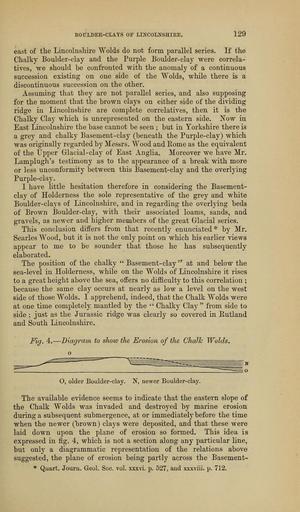MAKE A MEME
View Large Image

| View Original: | The_Quarterly_journal_of_the_Geological_Society_of_London_(14076394705).jpg (1183x2018) | |||
| Download: | Original | Medium | Small | Thumb |
| Courtesy of: | commons.wikimedia.org | More Like This | ||
| Keywords: The Quarterly journal of the Geological Society of London (14076394705).jpg BOULDEE-CLATS OF LINCOLNSHIRE 129 <br> east of the Lincolnshire Wolds do not form parallel series If the <br> Chalky Boulder-clay and the Purple Boulder- clay were correla- <br> tives we should be confronted with the anomaly of a continuous <br> succession existing on one side of the Wolds while there is a <br> discontinuous succession on the other <br> Assuming that they are not parallel series and also supposing <br> for the moment that the brown clays on either side of the dividing <br> ridge in Lincolnshire are complete correlatives then it is the <br> Chalky Clay which is unrepresented on the eastern side Now in <br> East Lincolnshire the base cannot be seen ; but in Yorkshire there is <br> a grey and chalky Basement-clay beneath the Purple-clay which <br> was originally regarded by Messrs Wood and Rome as the equivalent <br> of the Upper Glacial-clay of East Anglia Moreover we have Mr <br> Lamplugh's testimony as to the appearance of a break with more <br> or less unconformity between this Basement-clay and the overlying <br> Purple-clay <br> I have little hesitation therefore in considering the Basement- <br> clay of Holderness the sole representative of the grey and white <br> Boulder-clays of Lincolnshire and in regarding the overlying beds <br> of Brown Boulder-clay with their associated loams sands and <br> gravels as newer and higher members of the great Glacial series <br> This conclusion differs from that recently enunciated by Mr <br> Searles Wood but it is not the only point on which his earlier views <br> appear to me to be sounder that those he has subsequently <br> elaborated <br> The position of the chalky Basement-clay at and below the <br> sea-level in Holderness while on the Wolds of Lincolnshire it rises <br> to a great height above the sea offers no difficulty to this correlation ; <br> because the same clay occurs at nearly as low a level on the west <br> side of those Wolds I apprehend indeed that the Chalk Wolds were <br> at one time completely mantled by the Chalky Clay from side to <br> side ; just as the Jurassic ridge was clearly so covered in Rutland <br> and South Lincolnshire <br> Fig 4 ” Diagram to shoiu the Erosion of the Chalk Wolds <br> o <br> O older Boulder-clay N newer Boulder-clay <br> The available evidence seems to indicate that the eastern slope of <br> the Chalk W olds was invaded and destroyed by marine erosion <br> during a subsequent submergence at or immediately before the time <br> when the newer brown clays were deposited and that these were <br> laid down upon the plane of erosion so formed This idea is <br> expressed in fig 4 which is not a section along any particular line <br> but only a diagrammatic representation of the relations above <br> suggested the plane of erosion being partly across the Basemen t- <br> Quart Journ Geol Soc vol xxxvi p 527 and xxxviii p 712 37046971 114009 51125 Page 129 Text 41 http //www biodiversitylibrary org/page/37046971 1885 Geological Society of London Biodiversity Heritage Library The Quarterly journal of the Geological Society of London v 41 1885 Geology Periodicals Smithsonian Libraries bhl page 37046971 dc identifier http //biodiversitylibrary org/page/37046971 smithsonian libraries Information field Flickr posted date ISOdate 2014-04-30 Check categories 2015 August 26 CC-BY-2 0 BioDivLibrary https //flickr com/photos/61021753 N02/14076394705 2015-08-26 04 59 38 cc-by-2 0 PD-old-70-1923 The Quarterly journal of the Geological Society of London 1885 Photos uploaded from Flickr by Fæ using a script | ||||